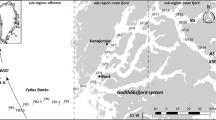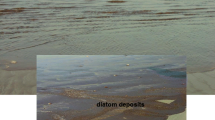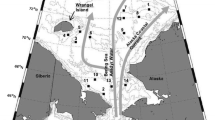Abstract
With the aims of investigating the response of the smallest benthic biota to a strong ice-edge-related input of phytodetritus, and of registering supposed lateral transportation processes of phytodetrital matter with northerly direction under the ice, we analysed a number of abiotic and biotic parameters in surface sediments from the northern Fram Strait. Two transects of 14 stations in total were made. One transect, crossing the Fram Strait from the east to the west, followed mainly the ice edge. The second transect extended latitudinally in a northerly direction, starting in ice-free areas, passing the ice edge, and ending in heavy ice-covered areas, approximately 100 nm north of the ice edge. Stations along this transect were sampled at almost constant water depths to avoid depth-related influences in our investigations. Results showed the expected high phytodetritus concentrations in the ice-edge vicinity. Concentrations of sediment-bound plant pigments were approximately 5 times higher than in ice-covered areas, indicating a very strong phytodetritus input. With increasing distance from the highly productive areas at the ice edge, we found significantly decreasing concentrations of phytodetrital input to the seafloor in a northerly direction. Within the foraminiferans, generic diversity was clearly reduced in the area of strong phytodetritus deposition. Along the latitudinal transect, out of the direct ice-edge influence, foraminiferal diversities slowly increased within increasing distance from the ice edge. The integration of results from earlier foraminiferal investigations, from stations further to the north, indicates a once more decreasing diversity with continually decreasing food supply.







Similar content being viewed by others
References
Altenbach AV (1992) Short term processes and patterns in the foraminiferal response to organic flux rates. Mar Micropaleontol 19:119–129
Barnett PRO, Watson J, Conelly D (1984) A multiple corer for taking virtually undisturbed samples from shelf, bathyal and abyssal sediments. Oceanol Acta 7:399–408
Billett DSM, Lampitt RS, Rice AL (1983) Seasonal sedimentation of phytoplankton to the deep-sea benthos. Nature 302:520–522
Boetius A, Damm E (1998) Benthic oxygen uptake, hydrolytic potentials and microbial biomass at the Arctic continental slope. Deep Sea Res 45:239–275
Boetius A, Lochte K (1994) Regulation of microbial enzymatic degradation of OM in deep-sea sediments. Mar Ecol Prog Ser 104:299–307
Boetius A, Lochte K (1996) Effect of organic enrichments on hydrolytic potentials and growth of bacteria in deep-sea sediments. Mar Ecol Prog Ser 140:239–250
Børsheim KY, Bratbak G, Heldal M (1990) Enumeration and biomass estimation of planktonic bacteria and viruses by transmission electron microscopy. Appl Environ Microbiol 56:352–356
Caswell H (1976) Community structure: a neutral model analysis. Ecol Monogr 46:327–354
Connell JH (1978) Diversity in tropical forests and coral reefs. Science 199:1302–1310
Corliss BH, Emerson S (1990) Distribution of Rose Bengal stained deep-sea benthic Foraminifera from the Nova Scotian continental margin and Gulf of Maine. Deep Sea Res 37:381–400
Cota GF, Legendre L, Gosselin M, Ingram RG (1991) Ecology of bottom ice algae. I. Environmental controls and variability. J Mar Syst 2:257–277
Ewens WJ (1972) The sampling theory of selectively neutral alleles. Theor Popul Biol 3:87–112
Falk-Petersen S, Hop H, Budgell WP, Hegseth EN, Korsnes R, Loeyning TB, Oerbaek JB, Kawamura T, Shirasawa K (2000) Physical and ecological processes in the marginal ice zone of the northern Barents Sea during the summer melt period. J Mar Syst 27:131–159
Findlay RH, Dobbs FC (1993) Quantitative description of microbial communities using lipid analysis. In: Kemp PF, Sherr BF, Sher EB, Cole JJ (eds) Handbook of methods in aquatic microbial ecology. Lewis, Boca Raton, pp 271–284
Goldman N, Lambshead PJD (1989) Optimization of the Ewens/Caswell neutral model program for community diversity analysis. Mar Ecol Prog Ser 50:255–261
Gooday AJ (1994) The biology of deep-sea foraminifera: a review of some advances and their applications in paleooceanography. Palaios 9:14–31
Gooday AJ, Carstens M, Thiel H (1995) Micro- and nanoforaminifera from abyssal Northeast Atlantic Sediments: a preliminary report. Int Rev Ges Hydrobiol 80:361–383
Gooday AJ, Pfannkuche O, Lambshead PJD (1996) An apparent lack of response by metazoan meiofauna to phytodetritus deposition in the bathyal north-eastern Atlantic. J Mar Biol Assoc UK 76:297–310
Greiser N, Faubel A (1988) Biotic factors. In: Higgins RP, Thiel H (eds) Introduction to the study of meiofauna. Smithsonian Institution, Washington, DC, pp 79–114
Grossmann S, Reichhardt W (1991) Impact of Arenicola Marina on bacteria in intertidal sediments. Mar Ecol Prog Ser 77:85–93
Hurlbert SH (1984) Pseudoreplication and the design of ecological field experiments. Ecol Monogr 54:187–211
Huston M (1979) A general hypothesis of species diversity. Am Nat 113:81–101
Kaleschke L, Lüpkes C, Vihma T, Haarpaintner J, Bochert A, Heygster G (2001) SSM/I Sea ice remote sensing for mesoscale ocean-atmosphere interaction analysis. Can J Remote Sensing 27:526–532
Karl DM (1993) Total microbial biomass estimation derived from the measurement of particulate adenosine-5′-triphosphate. In: Kemp PF, Sherr BF, Sher EB, Cole JJ (eds) Handbook of methods in aquatic microbial ecology. Lewis, Boca Raton, pp 271–284
Lambshead PJD, Platt HM (1988) Analysing disturbance with the Ewens/Caswell neutral model: theoretical review and practical assessment. Mar Ecol Prog Ser 43:31–41
Manley TO (1995) Branching of Atlantic water within the Greenland-Spitsbergen Passage: an estimate of recirculation. J Geophys Res 100:20627–20634
Meyer-Reil L-A, Köster M (1992) Microbial life in pelagic sediments: the impact of environmental parameters on enzymatic degradation of organic material. Mar Ecol Prog Ser 81:65–72
Murray JL (1998) Physical/geographical characteristics of the Arctic. In: Wilson SJ, Murray JL, Huntington HP (eds) AMAP assessment report: Arctic pollution issues. Arctic Monitoring and Assessment Programme (AMAP), Oslo, pp 9–24
Pfannkuche O, Thiel H (1987) Meiobenthic stocks and benthic activity on the NE-Svalbard Shelf and in the Nansen Basin. Polar Biol 7:253–266
Platt HM, Lambshead PJD (1985) Neutral model analysis of patterns of marine benthic species diversity. Mar Ecol Prog Ser 24:75–81
Rajendran N, Matsuda O, Urushigawa Y (1992) Distribution of polarlipid fatty acid biomarkers for bacteria in sediments of a polluted bay. Microbios 72:143–152
Rudels B, Meyer R, Fahrbach E, Ivanov VV, Østerhus S, Quadfasel D, Schauer U, Tverberg V, Woodgate RA (2000) Water mass distribution in Fram Strait and over the Yermak Plateau in summer 1997. Ann Geophys 18:687–705
Sakshaug E, Skjoldal HR (1989) Life at the ice edge. Ambio 18:60–67
Sakshaug E, Slagstad D (1991) Light and productivity of phytoplankton in polar marine ecosystems: a physiological view. Polar Res 10:69–85
Schewe I (2001) Small-sized benthic organisms of the Alpha Ridge, central Arctic Ocean. Int Rev Ges Hydrobiol 86:317–335
Schewe I, Soltwedel T (1999) Deep-sea meiobenthos of the central Arctic Ocean: distribution patterns and size-structure under extreme oligotrophic conditions. Vie Milieu 49:79–92
Smart CW, Gooday AJ (1997) Recent benthic foraminifera in the abyssal Northeast Atlantic Ocean: relation to phytodetrital inputs. J Foraminiferal Res 27:85–92
Soltwedel T, Schewe I (1998) Activity and biomass of the small benthic biota under permanent ice-coverage in the central Arctic Ocean. Polar Biol 19:52–62
Soltwedel T, Mokievsky V, Schewe I (2000) Benthic activity and biomass on the Yermak Plateau and in adjacent deep-sea regions northwest of Svalbard. Deep Sea Res I 47:1716–1785
Subba Rao DV, Platt T (1984) Primary production of Arctic waters. Polar Biol 3:191–201
Thiel H (1978) Benthos in upwelling regions. In: Boje R, Tomczak M (eds) Upwelling ecosystems. Springer, Berlin Heidelberg New York, pp 124–138
Venrick EL (1971) The statistics of subsampling. Limnol Oceanogr 16:811–818
Walsh JJ, McRoy CP, Coachman LK, Goering JJ, Nihoul JJ, Whitledge TE, Blackburn TH, Parker PL, Wirick CD, Shuert PG, Grebmeier JM, Springer AM, Tripp RD, Hansell DA, Djendi S, Deleersnijder E, Herinksen K, Lund BA, Andersen P, MuK ller-Karger FE, Dean K (1998) Carbon and nitrogen cycling within the Bering/Chuchki Seas: source regions for organic matter electing AOU demands of the Arctic Ocean. Progr Oceanogr 22:277–359
Wollenburg JE, Kuhnt W (2000) The response of benthic foraminifers to carbon flux and primary production in the Arctic Ocean. Mar Micropaleontol 40:189–231
Acknowledgements
We wish to thank the crew of the German icebreaker R/V Polarstern for their helpful support during the expedition ARK XV/2 in summer 1999, and Evelin Siebert for her help with measurements of several biogenic sediment compounds. We also gratefully acknowledge the anonymous reviewers for their valuable comments on the manuscript.
Author information
Authors and Affiliations
Corresponding author
Rights and permissions
About this article
Cite this article
Schewe, I., Soltwedel, T. Benthic response to ice-edge-induced particle flux in the Arctic Ocean. Polar Biol 26, 610–620 (2003). https://doi.org/10.1007/s00300-003-0526-8
Received:
Accepted:
Published:
Issue Date:
DOI: https://doi.org/10.1007/s00300-003-0526-8




